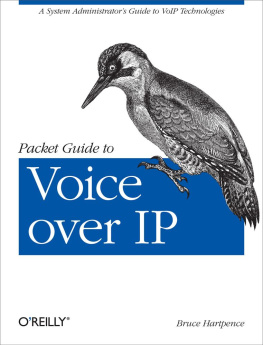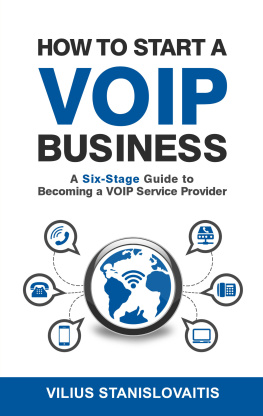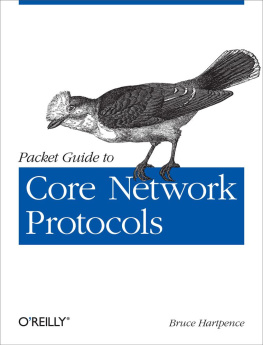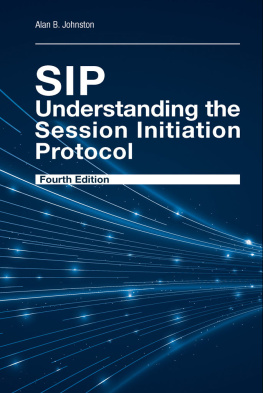Packet Guide to Voice over IP
Bruce Hartpence
Beijing Cambridge Farnham Kln Sebastopol Tokyo
Special Upgrade Offer
If you purchased this ebook directly from oreilly.com, you have the following benefits:
DRM-free ebooksuse your ebooks across devices without restrictions or limitations
Multiple formatsuse on your laptop, tablet, or phone
Lifetime access, with free updates
Dropbox syncingyour files, anywhere
If you purchased this ebook from another retailer, you can upgrade your ebook to take advantage of all these benefits for just $4.99. to access your ebook upgrade.
Please note that upgrade offers are not available from sample content.
Preface
A short while ago, as network engineers made plans for the future, one of the considerations was the eventuality of Voice over the Internet Protocol, or VoIP. For several years, VoIP was always on the horizon or around the corner, as many believed that it was coming but were unsure about the timing. The question was whether network designers and educational programs should become early adopters, building in capacity and knowledge now or whether they should make it part of the next deployment cycle. Pulling the trigger early might put you at risk of making the wrong decision in terms of vendor or protocol. Adopting late might put you behind the competition or make you rush to deploy a system that is not well understood by the local staff.
Voice over the Internet Protocol, a.k.a. Voice over IP, or VoIP, is a huge topic. Those trying to really understand how VoIP systems operate and the issues associated with their deployment must delve into protocols and architecture requirements such as power over Ethernet, or PoE. New security issues arise because voice is now packetized on the data network and accessible via ubiquitous wireless links. Quality-of-service issues associated with mixing data and voice on the same network cause headaches as network administrators are inundated with real-time data. Interconnecting IP voice connections with the public switched telephone network (PSTN) and unified communications (UC) brings additional concerns and increasing workloads to the beleaguered staff.
This book provides an explanation of VoIP from the perspective of operating networks and the packets caught on those networks. Since the topologies were built for the purpose of developing content for the book, the issues and supporting structures necessary for VoIP are also explored. Thus, readers will get a firsthand under-the-hood view of the protocols and architectures used by VoIP-based systems as we track connections from the time VoIP phones boot, through calls and during subsequent connection teardown. Like the previous Packet Guide books (OReillys Packet Guide to Core Network Protocols and the Packet Guide to Routing and Switching ), the tool of choice for viewing the packets will be Wireshark, which is still available for free out at wireshark.org . The author built and configured everything seen in this book.
Most basic packetized voice networks start of with some very similar components; will begin with these. Components include not only VoIP-specific items such as gateways and phones but also requirements such as Dynamic Host Configuration Protocol (DHCP) and Trivial File Transfer Protocol (TFTP).
The files and website support the lab activities in this book. Simple networking experiences can be accomplished on almost any topology. However, it is not always possible to obtain the resources necessary to build and study voice networks. So, for the lab activities in this book, I have posted capture files posted on the companion website. For additional background, a YouTube channel provides another resource.
With the exception of those for Skinny, all of the references used for this book are standards from the ITU-T (International Telecommunications Union-Telecom), the IEEE (Institute of Electrical and Electronics Engineers), Request for Comments (RFC) from the Internet Engineering Task Force, or material obtained from operating networks.
Audience
I had several folks in mind when I wrote the Packet Guide books: instructors, students, professionals, and those seeking information to boost their skill set. While the first two books covered topics that are part of almost every single network and this one focuses on a particular area, the goal and the audience have not changed. My goal in writing these is to provide the background to understand the issues but also take an in-depth look at the protocols and operations that are part of a VoIP architecture. A student who reads this book and completes the exercises will be conversant in this important area and will have obtained valuable practical knowledge. A professional looking to brush up or change jobs will gain the necessary leg up or at least knock the rust off. In either case, I hope you enjoy the read.
Contents of This Book
This chapter provides the foundation for the book. It includes the requirements for a basic VoIP topology and describes the issues associated with deploying packetized voice and video. Readers will also come to understand critical topics such as codecs and power over Ethernet.
Every data network must eventually connect to the rest of the world via the Internet. For VoIP, this usually means connecting to the global telephony network, the uses of which continue to include traditional connectivity. This chapter will familiarize the reader with traditional telephony concepts that will typically be a part of their lives as VoIP administrators including local loop, tip and ring, T carriers, and the necessary protocol conversations.
Most VoIP pundits agree that the Session Initialization Protocol, or SIP, is taking over the VoIP world, and I am no different. As a result, SIP will be the first signaling protocol that we will discuss in this book and will form the basis for comparisons made throughout the other chapters. As an Internet Engineering Taskforce request for comments, SIP enjoys wide industry support and shares many characteristics with other common web protocols such as the Hypertext Transfer Protocol, making it easy to understand and read.
VoIP protocols are broken into two categories: signaling and transport. The Real-Time Transport Protocol (RTP) and its sidekick, the Real-Time Control Protocol (RTCP), fall into the latter category. Almost every voice or video stream created via signaling protocols such as SIP or H.323 are carried by RTP. RTCP provides information about the stream. This chapter will cover the operation and fields for both protocols. It will also provide some practical information for their deployment.
At the center of all voice and video streams is the need to convert analog data to digital for transmission across the network. A codec or coder/decoder is the tool used for this purpose. The proper choice of codec can make the difference between a successful rollout and one that leaves the users questioning your ability. This chapter will spend time on both voice and video codecs, their operation, and the decision process used in making the correct choice.
H.323 became the de facto standard for Internet Telephony mostly because it was the early standard developed for video conferencing. Actually a protocol suite containing subprotocols, H.323 saw wide deployment, which is the reason for its inclusion here. Even though it is slowly being supplanted by SIP, it is still quite common for practitioners to run into H.323, requiring them to manage integration or conversion.










